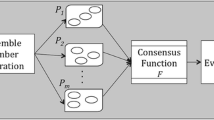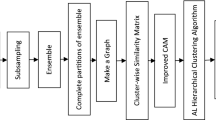Abstract
For obtaining the more robust, novel, stable, and consistent clustering result, clustering ensemble has been emerged. There are two approaches in clustering ensemble frameworks: (a) the approaches that focus on creation or preparation of a suitable ensemble, called as ensemble creation approaches, and (b) the approaches that try to find a suitable final clustering (called also as consensus clustering) out of a given ensemble, called as ensemble aggregation approaches. The first approaches try to solve ensemble creation problem. The second approaches try to solve aggregation problem. This paper tries to propose an ensemble aggregator, or a consensus function, called as Robust Clustering Ensemble based on Sampling and Cluster Clustering (RCESCC).RCESCC algorithm first generates an ensemble of fuzzy clusterings generated by the fuzzy c-means algorithm on subsampled data. Then, it obtains a cluster-cluster similarity matrix out of the fuzzy clusters. After that, it partitions the fuzzy clusters by applying a hierarchical clustering algorithm on the cluster-cluster similarity matrix. In the next phase, the RCESCC algorithm assigns the data points to merged clusters. The experimental results comparing with the state of the art clustering algorithms indicate the effectiveness of the RCESCC algorithm in terms of performance, speed and robustness.







Similar content being viewed by others
References
Wang B, Zhang J, Liu Y, Zou Y (2017) Density peaks clustering based integrate framework for multi-document summarization. CAAI Transactions on Intelligence Technology 2(1):26–30
Ma J, Jiang X, Gong M (2018) Two-phase clustering algorithm with density exploring distance measure. CAAI Transactions on Intelligence Technology 3(1):59–64
Deng Q, Wu S, Wen J, Xu Y (2018) Multi-level image representation for large-scale image-based instance retrieval. CAAI Transactions on Intelligence Technology 3(1):33–39
Chakraborty D, Singh S, Dutta D (2017) Segmentation and classification of high spatial resolution images based on Hölder exponents and variance. Geo-spatial Information Science 20(1):39–45
Yang H, Yu L (2017) Feature extraction of wood-hole defects using wavelet-based ultrasonic testing. J For Res 28(2):395–402
Li C, Zhang Y, Tu W et al (2017) Soft measurement of wood defects based on LDA feature fusion and compressed sensor images. J For Res 28(6):1285–1292
Alsaaideh B, Tateishi R, Phong DX, Hoan NT, Al-Hanbali A, Xiulian B (2017) New urban map of Eurasia using MODIS and multi-source geospatial data. Geo-spatial Information Science 20(1):29–38
Song XP, Huang C, Townshend JR (2017) Improving global land cover characterization through data fusion. Geo-spatial Information Science 20(2):141–150
Strehl A, Ghosh J (2003) Cluster ensembles—a knowledge reuse framework for multiple partitions. The Journal of Machine Learning Research 3:583–617
Alizadeh H, Minaei-Bidgoli B, Parvin H (2014b) To improve the quality of cluster ensembles by selecting a subset of base clusters. Journal of Experimental & Theoretical Artificial Intelligence 26(1):127–150
Mondal S, Banerjee A (2015) ESDF: ensemble selection using diversity and frequency. Eprint Arxiv 68(1):10–12
Naldi MC, Carvalho AC, Campello RJ (2013) Cluster ensemble selection based on relative validity indexes. Data Min Knowl Disc 27(2):259–289
Ni Z, Wu X, Ni L, Tang L, Xiao H (2015) The research on selective clustering ensemble algorithm based on fractal dimension and projection. Journal of Computational Information Systems 11(11):4025–4035
X. Wang, D. Han, C. Han, Rough set based cluster ensemble selection, information FUSION (FUSION), 2013a
Yang F, Li T, Zhou Q, Xiao H (2017) Cluster ensemble selection with constraints. Neurocomputing 235:59–70
Yousefnezhad M, Reihanian A, Zhang D, Minaei-Bidgoli B (2016) A new selection strategy for selective cluster ensemble based on diversity and independency. Eng Appl Artif Intell 56(C):260–272
Minaei-Bidgoli B, Parvin H, Alinejad-Rokny H, Alizadeh H, Punch WF (2013) Effects of resampling method and adaptation on clustering ensemble efficacy. Artif Intell Rev 41(1):27–48
Yu Z, Chen H, You J, Wong HS (2014) Double selection based semi-supervised clustering ensemble for tumor clustering from gene expression profiles, IEEE/ACM transactions on computational biology. Bioinformatics 11(4):727–740
Kao LJ, Huang YP (2013) Ejecting outliers to enhance robustness of fuzzy cluster ensemble. In: IEEE international conference on systems, man, and cybernetics, pp 3790–3795
Mishra SP, Mishra D, Patnaik S (2015) An integrated robust semi-supervised framework for improving cluster reliability using ensemble method for heterogeneous datasets. Karbala International Journal of Modern Science 1(4):200–211
Akbari E, Dahlan HM, Ibrahim R, Alizadeh H (2015) Hierarchical cluster ensemble selection. Eng Appl Artif Intell 39(39):146–156
H. Wang, J. Qi, W. Zheng, M. Wang, Semi-supervised cluster ensemble based on binary similarity matrix, in: The IEEE International Conference on Information Management and Engineering, 2010, pp. 251–254
Alizadeh H, Minaei B, Parvin H (2013) Optimizing fuzzy cluster Ensemble in String Representation. International Journal of Pattern Recognition and Artificial Intelligence, IJPRAI, ISSN:0218–0014
Meng J, Hao H, Luan Y (2016) Classifier ensemble selection based on affinity propagation clustering. J Biomed Inform 60:234–242
Soltanmohammadi E, Naraghi-Pour M, Schaar MVD (2016) Context-based unsupervised ensemble learning and feature ranking. Mach Learn 105(3):1–27
Wang D, Li L, Yu Z, Wang X (2013b) AP2CE: double affinity propagation based cluster ensemble. In: International conference on machine learning and cybernetics, pp 16–23
Yu Z, Luo P, You J, Wong HS, Leung H, Wu S, Zhang J, Han G (2016) Incremental semi-supervised clustering ensemble for high dimensional data clustering. IEEE Transactions on Knowledge & Data Engineering 28(3):701–714
Iam-On N, Boongoen T, Garrett S, Price C (2011) A link-based approach to the cluster ensemble problem. IEEE transactions on Pattern Analysis & Machine Intelligence 33(12):2396–2409
Zhong C, Yue X, Zhang Z, Lei J (2015) A clustering ensemble: two-level-refined co-association matrix with path-based transformation. Pattern Recogn 48(8):2699–2709
Wang LJ, Hao ZF, Cai RC, Wen W (2014) An improved local adaptive clustering ensemble based on link analysis. In: International conference on machine learning and cybernetics, pp 10–15
Xiao W, Yang Y, Wang H, Li T, Xing H (2016) Semi-supervised hierarchical clustering ensemble and its application. Neurocomputing 173:1362–1376
Wang W (2008) Some fundamental issues in ensemble methods. In: proceedings of the IEEE international joint conference on neural networks, IEEE world congress on. Comput Intell:2243–2250
Jain AK, Murty MN, Flynn PJ (1999) Data clustering: a review. ACM computing surveys (CSUR) 31(3):264–323
Tan PN, Steinbach M, Kumar V (2006) Introduction to data mining. In: Pearson Addison Wesley (Boston)
Dunn JC (1973) A fuzzy relative of the ISODATA process and its use in detecting compact well-separated clusters. Journal of Cybernetics 3:32–57
Berikov VB (2018) A probabilistic model of fuzzy clustering ensemble. Pattern Recognition and Image Analysis 28(1):1–10. https://doi.org/10.1134/S1054661818010029
Dimitriadou E, Weingessel A, Hornik K (2002) A combination scheme for fuzzy clustering. Int J Pattern Recognit Artif Intell 16(07):901–912
Li T, Chen Y (2010) Fuzzy clustering ensemble with selection of number of clusters. JCP 5(7):1112–1119
Nazari A, Dehghan A, Nejatian S, Rezaie V, Parvin H (2018) A comprehensive study of clustering ensemble weighting based on cluster quality and diversity. Pattern Anal Applic. https://doi.org/10.1007/s10044-017-0676-x
Pan S, Changjing S, Qiang S (2015) A hierarchical fuzzy cluster ensemble approach and its application to big data clustering. Journal of Intelligent & Fuzzy Systems 28(6):2409–2421
Parvin H, Minaei-Bidgoli B (2015) A clustering ensemble framework based on selection of fuzzy weighted clusters in a locally adaptive clustering algorithm. Pattern Anal Appl 18(1):87–112
Sevillano X, JC S’o, Alıas F (2009) Fuzzy clusterers combination by positional voting for robust document clustering. Procesamiento del lenguaje natural 43:245–253
Alqurashi T, Wang W (2015) A new consensus function based on dual-similarity measurements for clustering ensemble. In: International conference on data science and advanced analytics (DSAA), IEEE. ACM, pp 149–155
Fern XZ, Brodley CE (2003) Random projection for high dimensional data clustering: A cluster ensemble approach. In: Proceedings of the 20th International Conference on Machine Learning, pp 186–193, URL http://www.aaai.org/Papers/ICML/2003/ICML03–027.pdf
Breiman L (1996) Bagging predictors. Mach Learn 24:123–140
Minaei-Bidgoli B, Topchy A, Punch WF (2004) Ensembles of partitions via data resampling. In: Proceedings of the international conference on information technology: coding and computing ITCC, IEEE, vol 2, pp 188–192
Parvin H, Minaei-Bidgoli B, Alinejad-Rokny H, Punch WF (2013) Data weighing mechanisms for clustering ensembles. Computers & Electrical Engineering 39(5):1433–1450
Alizadeh H, Yousefnezhad M, Minaei-Bidgoli B (2015) Wisdom of crowds cluster ensemble. Intell Data Anal 19(3):485–503
Topchy A, Jain AK, Punch W (2004) A mixture model of clustering ensembles. Proceedings of the SIAM International Conference of Data Mining, In
Iam-on N, Boongoen T, Garrett S (2010) LCE: a link-based cluster ensemble method for improved gene expression data analysis. Bioinformatics 26(12):1513–1519
Iam-On N, Boongeon T, Garrett S, Price C (2012) A link based cluster ensemble approach for categorical data clustering. IEEE Trans Knowl Data Eng 24(3):413–425
Yi J, Yang T, Jin R, Jain AK, Mahdavi M (2012) Robust ensemble clustering by matrix completion. In: proceedings of the IEEE 12th international conference on data mining (ICDM). IEEE:1176–1181
Gionis A, Mannila H, Tsaparas P (2007) Clustering aggregation. ACM Transactions on Knowledge Discovery from Data (TKDD) 1(1):4–es
Alqurashi T, Wang W (2014) Object-neighborhood clustering ensemble method. In: Intelligent data engineering and automated learning (IDEAL). Springer, pp 142–149
Fred AL, Jain AK (2005) Combining multiple clustering's using evidence accumulation. IEEE Trans Pattern Anal Mach Intell 27(6):835–850
Yang Y, Jiang J (2016) Hybrid sampling-based clustering ensemble with global and local constitutions. IEEE Transactions on Neural Networks and Learning Systems 27(5):952–965
Bai L, Cheng X, Liang J, Guo Y (2017) Fast graph clustering with a new description model for community detection. Inf Sci 388-389:37–47
Karypis G, Kumar V (1998) A fast and high quality multilevel scheme for partitioning irregular graphs. SIAM J Sci Comput 20(1):359–392
Fern XZ, Brodley CE (2004) Solving cluster ensemble problems by bipartite graph partitioning. In: Proceedings of the 21st International Conference on Machine learning, ACM, p 36
Huang D, Lai J, Wang CD (2016b) Robust ensemble clustering using probability trajectories. The IEEE Transactions on Knowledge and Data Engineering, Robust Ensemble Clustering Using Probability Trajectories
Huang D, Lai J, Wang CD (2016a) Ensemble clustering using factor graph. Pattern Recogn 50:131–142
Houle ME (2008) The relevant-set correlation model for data clustering. Statistical Analysis and Data Mining 1(3):157–176
Vinh NX, Houle ME (2010) A set correlation model for partitional clustering. Advances in Knowledge Discovery and Data Mining, Springer, In, pp 4–15
D. Dueck, “Affinity propagation: Clustering data by passing messages,” Ph.D. dissertation, University of Toronto, 2009
Newman CBDJ, SS Hettich, C Merz (1998) UCI repository of Mach Learn databases, http://www.ics.uci.edu/˜mlearn/MLSummary.html, (1998)
Ren Y, Zhang G, Domeniconi C, Yu G (2013) Weighted object ensemble clustering. In: Proceedings of the IEEE 13th International Conference on Data Mining (ICDM), IEEE, pp 627–636
Mimaroglu S, Aksehirli E (2012) DICLENS: divisive clustering ensemble with automatic cluster number. IEEE/ACM Transactions on Computational Biology and Bioinformatics (TCBB) 9(2):408–420
Alizadeh H, Minaei-Bidgoli B, Parvin H (2014a) Cluster ensemble selection based on a new cluster stability measure. Intelligent Data Analysis 18(3):389–408
Huang D, Lai JH, Wang CD (2015) Combining multiple clusterings via crowd agreement estimation and multi-granularity link analysis. Neurocomputing 170:240–250
Hubert L, Arabie P (1985) Comparing partitions. J Classif 2(1):193–218
Acknowledgments
This paper is extracted from a PhD thesis written by Musa Mojarad.
Author information
Authors and Affiliations
Corresponding author
Additional information
Publisher’s Note
Springer Nature remains neutral with regard to jurisdictional claims in published maps and institutional affiliations.
Rights and permissions
About this article
Cite this article
Mojarad, M., Nejatian, S., Parvin, H. et al. A fuzzy clustering ensemble based on cluster clustering and iterative Fusion of base clusters. Appl Intell 49, 2567–2581 (2019). https://doi.org/10.1007/s10489-018-01397-x
Published:
Issue Date:
DOI: https://doi.org/10.1007/s10489-018-01397-x




